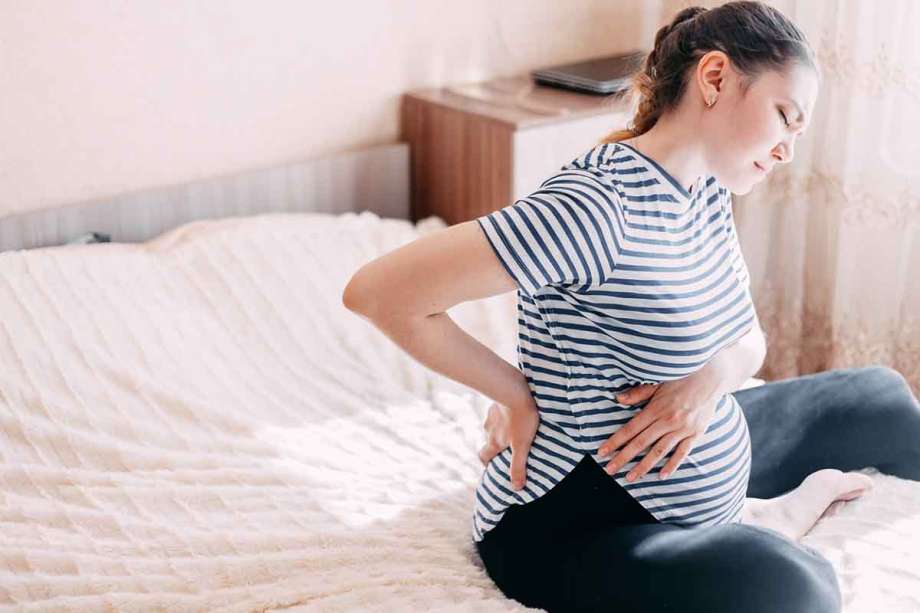A Physical Therapist's Guide to Back and Hip Pain Relief During Pregnancy

Pregnancy comes with physical changes. Unfortunately, many of those changes are associated with increased pain in the third trimester and beyond. Studies show that pregnant women have frequent musculoskeletal pain in both the low back (71%) and hips (32%), while one-third of new moms have back pain that continues post-partum.
More: The Best Pregnancy Pillows According to Real Moms
To prevent and reduce back and hip pain, here are some key muscles to release before, during, and after pregnancy.
What Causes Muscle Tension During Pregnancy?
During pregnancy, your body releases a chemical called relaxin to prepare your body for birth.
Relaxin softens and relaxes the ligaments around your pelvic area to ensure your baby can emerge smoothly from the birth canal.
As the ligaments begin to loosen, your body may react by tightening the muscles around the hip joints to stabilize the pelvis. By the delivery date, your pelvis is hypermobile, making your iliopsoas (your primary hip flexors) shorten and tighten to stabilize. This iliopsoas muscle tension can be the cause of increased pain during pregnancy.
How Do Tight Muscles Cause Hip and Back Pain?
Your iliopsoas muscles – your primary hip flexors – are made up of two muscles: the iliacus and psoas. Together, these muscles travel diagonally through your core, connecting your lower spine, the inside of your pelvis, and the top of your thigh bone. With the important job of connecting your upper half to your lower half, these muscles are active throughout most of your day: walking, running, kicking, sitting, or squatting.
People who haven’t been pregnant or given birth can experience tight hip flexors, but pregnancy adds additional strain. Tight hip flexor muscles are often overlooked as a cause of lower back and hip pain, even though they are an extremely common issue - especially during pregnancy.
This muscle tension from tight iliopsoas muscles also adds unnecessary strain on the other connective tissues in your hip area, including the tailbone, sacroiliac (SI) joint, and hip joint itself. Iliopsoas muscle tension can cause your hips to be pulled out of alignment: impacting posture, walking, and sleep.
Having an aligned spine and tailbone/SI joint is key to pelvic happiness. Releasing the iliopsoas, the muscles in the back of the hip, and pelvic realignment exercises will help you reach this goal.
Releasing Iliopsoas Muscle Tension During Pregnancy
Depending on the stage of your pregnancy or motherhood, how you address iliopsoas tension will differ. These muscles are already hard to reach, and when you’re pregnant they are increasingly inaccessible.
During pregnancy, you can’t lay on your stomach to easily release your hips flexors with targeted tools through the abdomen. Many physical therapists are trained in ways to release muscle tension (and specifically the iliacus) that will be safe for you and your baby during pregnancy. If you’ve been getting frequent chiropractic, but the alignment won’t stick, you’ll want to address the underlying iliacus muscle tension.
Releasing the Back of Your Hip (the Piriformis Muscle)
While pregnant, one of the best things you can do is focus on releasing tension through the back of your hip and buttocks - at least that area is still accessible! The muscles in the back of the hip have a direct impact on hip flexor tightness. The primary muscle to focus on is the piriformis muscle. To do this, you can use a lacrosse ball, tennis ball, or specialized hip flexor release ball.
The piriformis is important in releasing hip tension because the sciatic nerve runs underneath it. Tension in the piriformis can cause impingement of the sciatic nerve, creating sciatic pain down the leg. A tight piriformis can also pull the sacroiliac joint out of alignment: that spot on either side of the base of your spine at the dimples.
To release the piriformis muscle, follow these simple steps:
- Lay on your back with your knees bent
- Place a Hip Flexor Release Ball under your glute, near the center of one buttcheek
- Lower your weight onto the ball, find a tight spot, and relax into it
- Apply prolonged pressure to this spot for 30-90 seconds
- Do this on both sides
Once your body has recovered from birth, you can benefit from releasing the iliopsoas from the front with a hip flexor release tool that accesses both the iliacus and the psoas or seeking the help of a practitioner. Focus on spending ten minutes a day keeping these muscles free from tension, understanding the anatomy of your iliopsoas, and enjoying pregnancy and motherhood free from muscle pain!
Christine Koth, MPT, CEO/Co-founder of Aletha Health, bestselling author, and inventor of the Hip Hook, is a holistic Physical Therapist with 20 years in clinical practice specializing in muscle-tension issues. She helps people improve performance and reduce pain by creating resources and tools that target the source of pain, not the symptoms.
